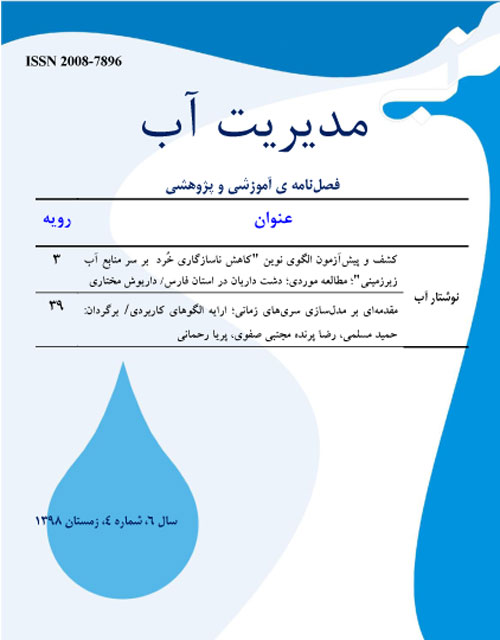فهرست مطالب

نشریه مدیریت آب
سال ششم شماره 4 (پیاپی 19، زمستان 1398)
- بهای روی جلد: 200,000ريال
- تاریخ انتشار: 1399/01/20
- تعداد عناوین: 2
-
صفحه 4
برای کشف و پیش آزمون الگوی "کاهش ناسازگاری خرد بر سر منابع آب زیرزمینی"، ابتدا محدوده دشت داریان به 10 پهنه مدیریتی تقسیم شد. جامعه هدف مطالعه شامل 852 مالک حلقه چاه آب کشاورزی بوده است. در یک نمونه ی تصادفی طبقه بندی شده، شمار 100 چاه در پهنه های یادشده برگزیده شدند و 20 خردهگروه چاهداران که هر کدام شامل 5 بهره بردار مالک چاه مجاور یکدیگر بودند، تشکیل و آزمون شدند. پیش آزمون با کمک انجام مصاحبه ی اکتشافی با 42 بهره بردار از میان همان 100 بهرهبردار و پیمایش میدانی محدوده مزرعه و چاه های مجاورشان انجام شد.
نتایج پیش آزمون ها نشان داد که شکل گیری ساختار واحد مدیریت آب بران بر پایه تشکیل خرده گروه های چاه داران، بستر حقوقی و اداری مناسبی برای کاهش ناسازگاری بر سر منابع آب زیرزمینی از طریق خودکنترلی در بهره برداری و حفاظت از منابع آب زیرزمینی دشت داریون پدید می آورد.کلیدواژگان: آب زیرزمینی، کاهش ناسازگاری خرد، دشت داریان -
صفحه 40
مدل سازی سری های زمانی که بر تحلیل داده ها متکی است چهار فاز کلی را شامل می شود: تشخیص، تحلیل، ترکیب و تایید. قضاوت ضعیف در هر یک از چهار فاز به یک مدل کمتر بهینه منجر خواهد شد. در تجزیه ی یک سری زمانی، پنج جزء کلی وجود دارند که ممکن است همگی آنها در یک سری زمانی حضور داشته باشند یا بالعکس. سه جزء را میتوان به عنوان سیستماتیک توصیف کرد: روندهای درازمدت، دوره ای و سیکلی. وقایع اپیزودیک و تغییرات تصادفی، اجزایی هستند که منابع تغییر غیر سیستماتیک را منعکس می کنند. در هر مورد یک مثال عملی ارایه شده است. برای نمونه، کاربرد این مدل سازی برای پیشبینی پیک سالانه تخلیه ها برای انشعاب شمال غربی رودخانه آناکوستیا[1] در هیتسویل[2] مریلند برای سال های آبی 1939 تا 1988 نشان داد که مدل لجستیک ممکن است یک مدل معقول برای نشان دادن بخش میانی روند درازمدت باشد.
کلیدواژگان: بحران آب، رودخانه های مرزی، دیپلماسی آبی
-
Page 4
To discover and pre-test of pattern of "micro conflict resolution over groundwater resources", at first, the Darian Plain area was divided into 10 management zones. The study population included 852 owners of agricultural water wells. In a randomized classified sample, 100 wells were selected in the mentioned areas and 20 micro groups of wells,that each containing 5 exploiters of the owner of the well neighboring to each other, were formed and tested. The pre-test was conducted with the help of exploratory interviews with 42 operators between of the same 100 operators and field surveys of the farm area and neighboring wells. The results of the pre-tests showed that the formation of the structure of the water management unit based on the formation of microgroups of wells, creates a legal and administrative platform to reduce incompatibility over groundwater resources through self-control in operation and protection of groundwater resources in Daryoun Plain.
Keywords: Groundwater, micro conflict resolution, Darian plain -
Page 40
Series modeling involves four general phases when relying on data analysis: diagnosis, analysis, composition, and validation. Unfortunate judgment in each of the four phases will lead to a less optimal model. In the analysis of a time series, there are five general components, that all of which may be present in a time series or vice versa. Three components can be described as systematic: long-term, periodic, and cyclical trends. Episodic events and random changes are components that reflect sources of non-systematic change. In each case, a practical example is provided. For example, the use of this modeling to predict the annual peak of discharges for the northwestern branch of the Anakostia river in Hitcheville, Maryland for water years 1939 to 1988, showed that the logistics model may be a reasonable model to show the middle section of the trend of long-term.
Keywords: Water crisis, border rivers, long-term, periodic, and cyclical trends

